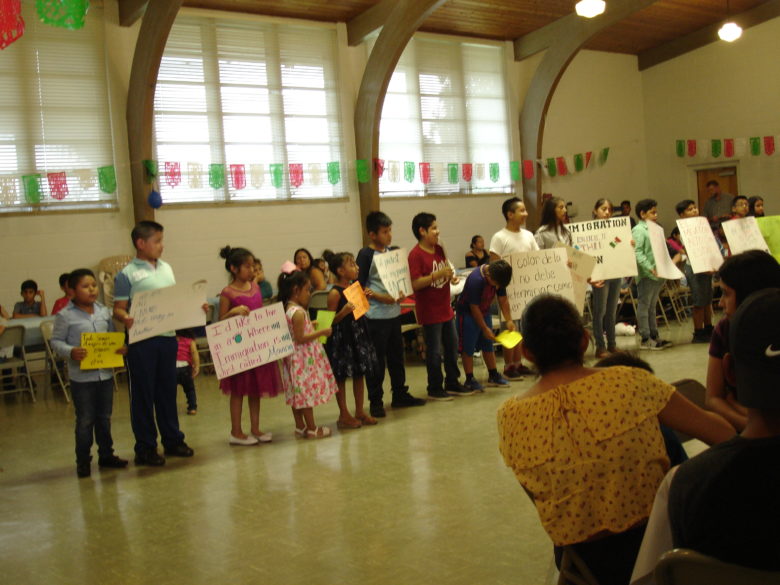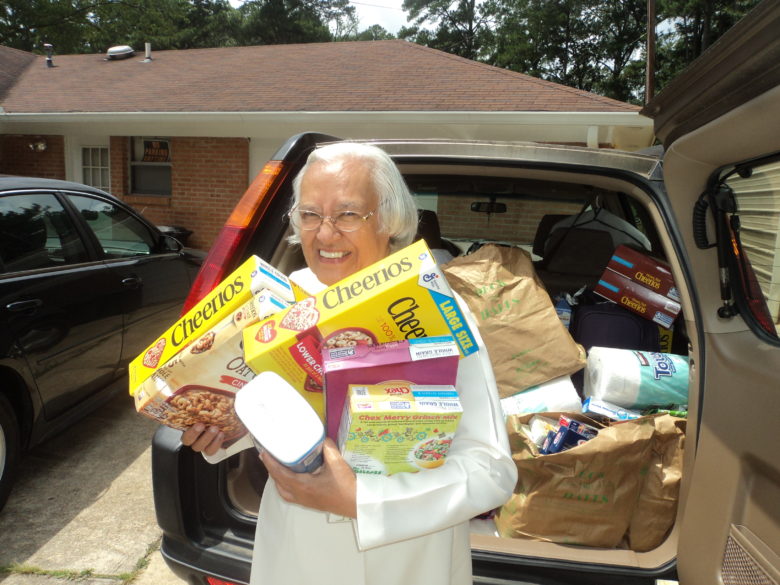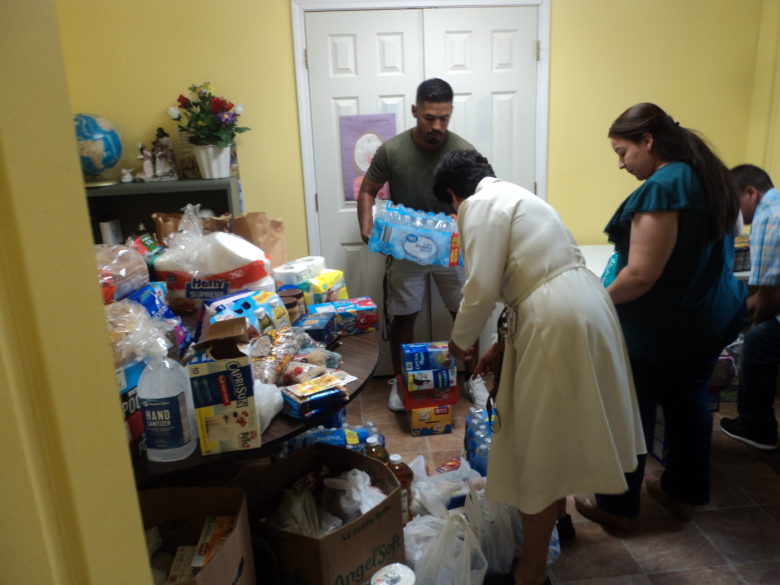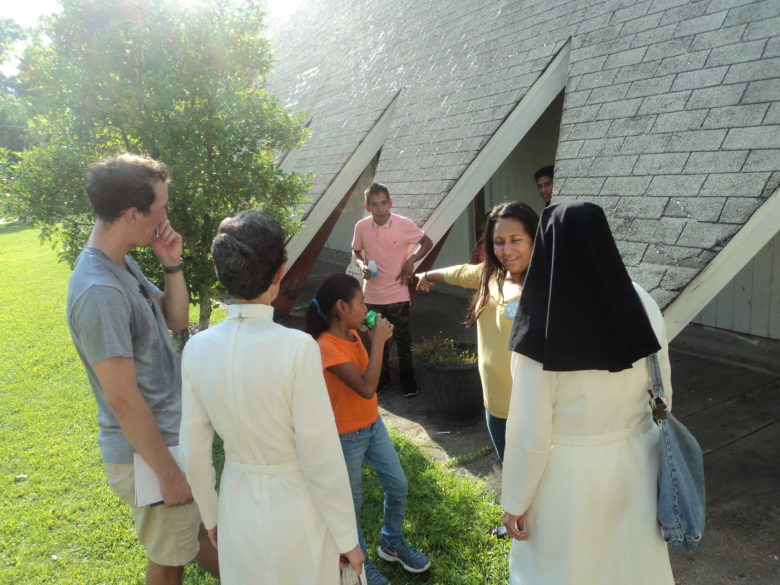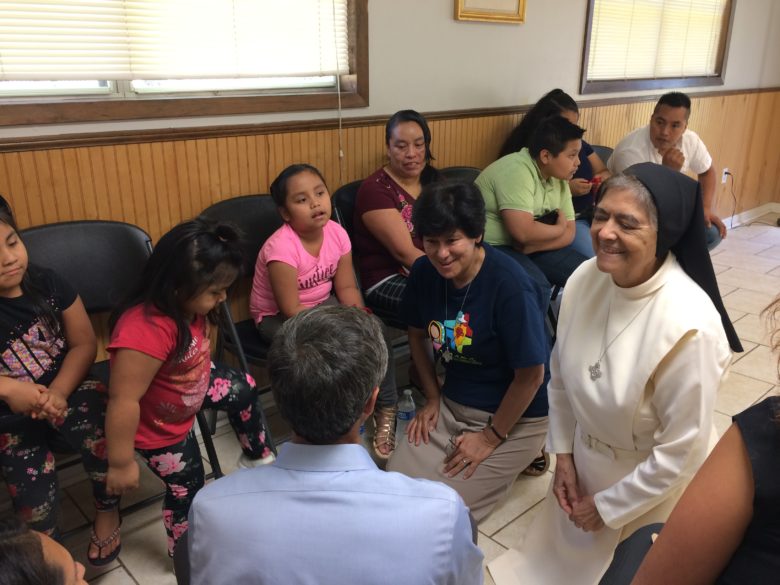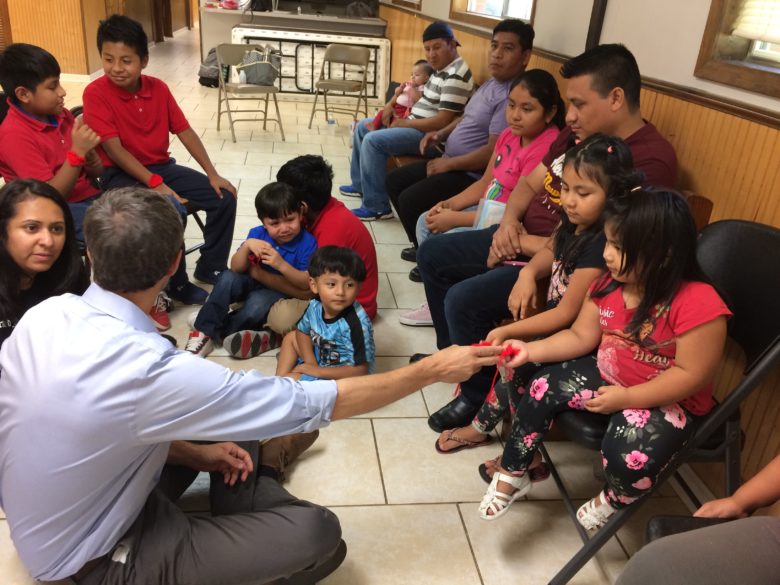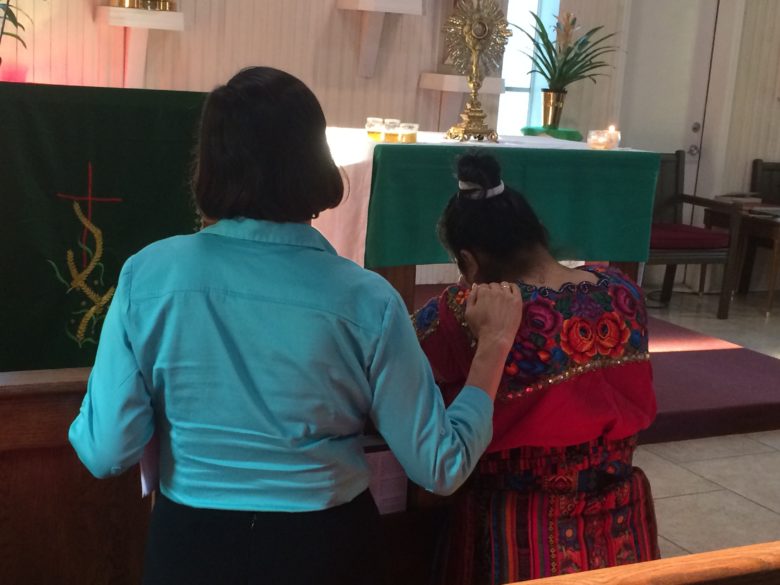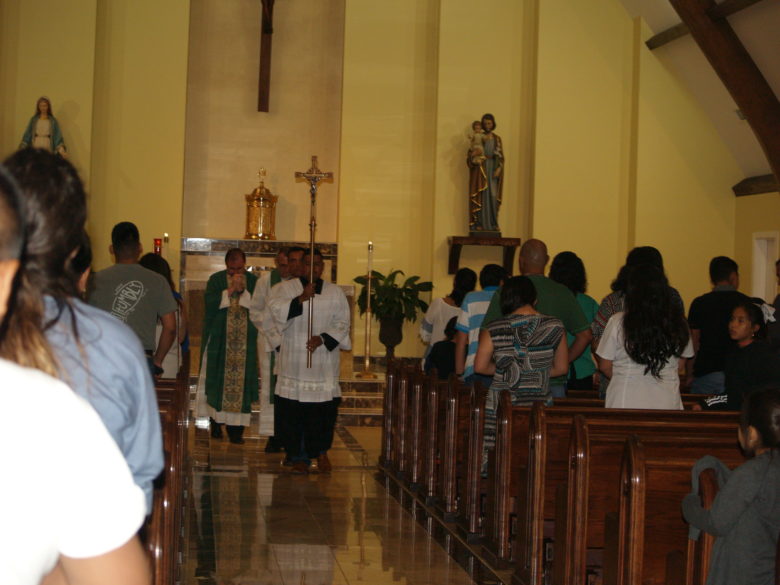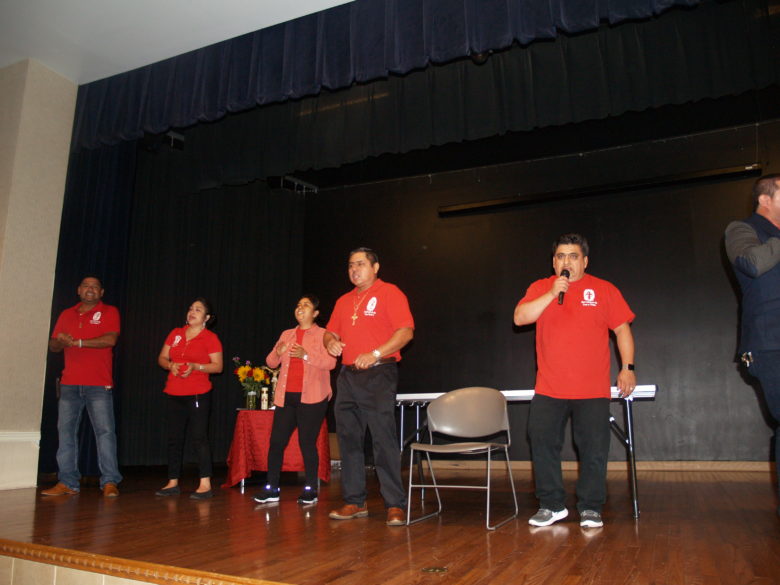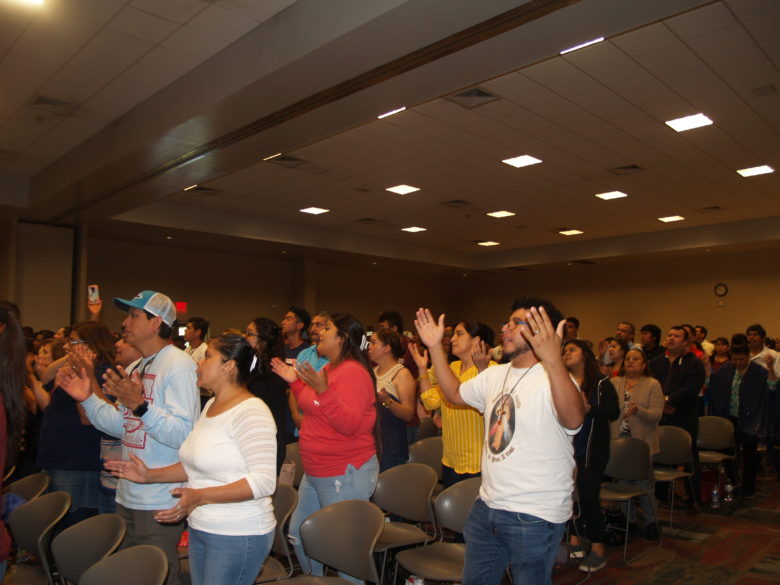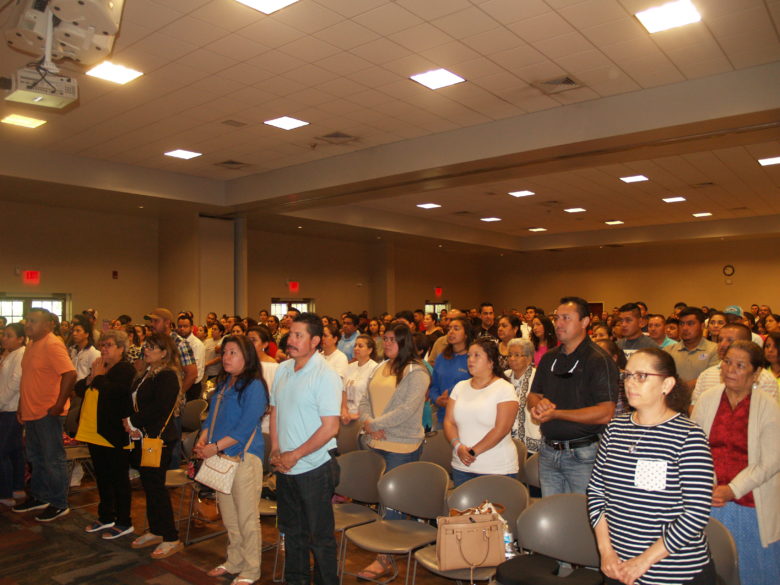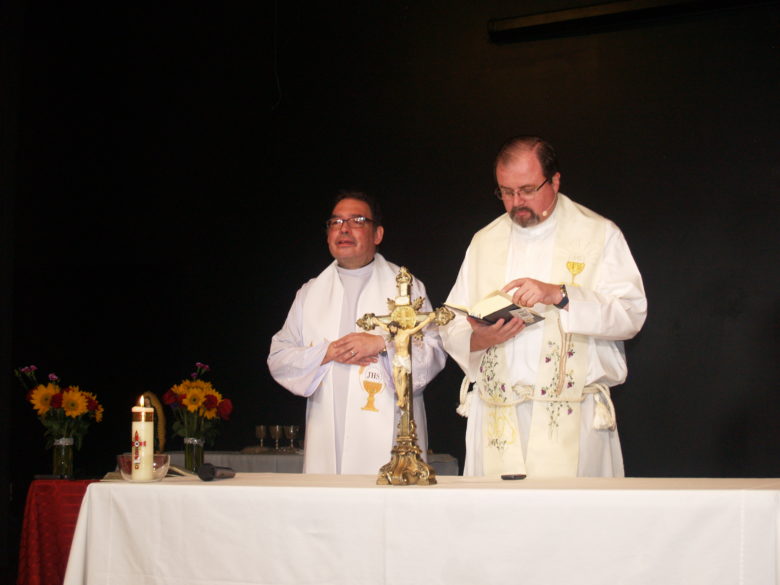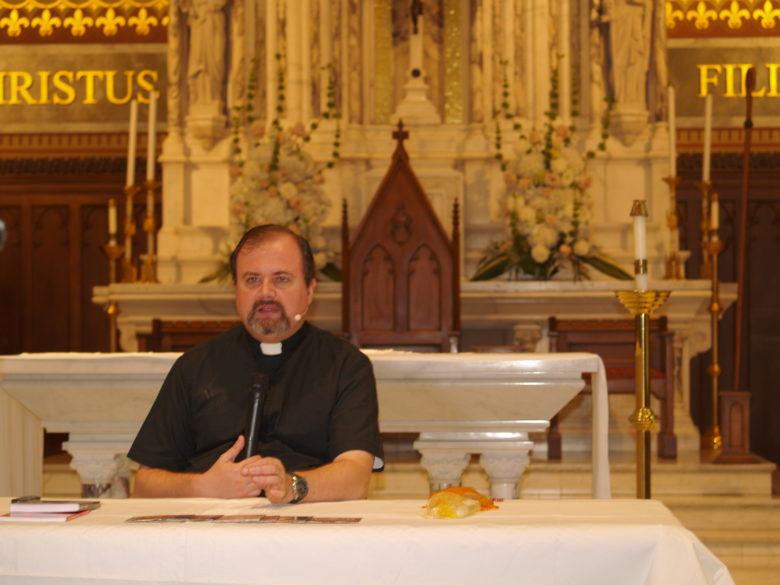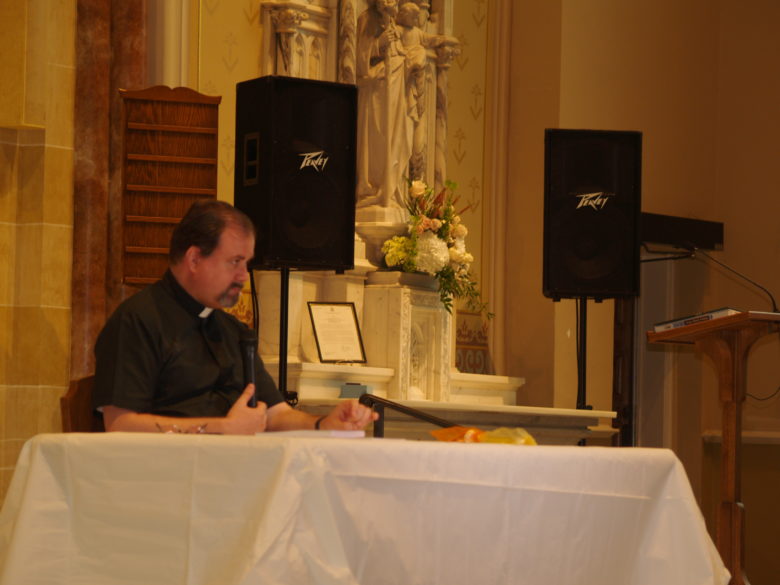Por Catholic News Service
CHICAGO (CNS) – La organización Extensión Católica, (Catholic Extension, por su nombre en inglés) ayudará en Mississippi a familias que fueron dejadas sin su principal apoyo financiero, aquellas que perdieron el principal sostén de la familia después que el Servicio de Inmigración y Control de Aduanas de los Estados Unidos llevó a cabo redadas masivas el 7 de agosto.
La organización católica, con sede en Chicago, dijo que enviaría ayuda de inmediato, pero también comenzaría a recaudar fondos para beneficiar a los necesitados a través de su “Fondo de la Sagrada Familia”, un programa que lanzó a principios de este año para ayudar financieramente a esposos, esposas e hijos que se quedaron sin su principal sostén por razones de detención o deportación.
La ayuda será administrada por la Diócesis de Jackson. “El programa busca traer algo de estabilidad a lo que es un momento terriblemente desestabilizador para las familias”, dijo la organización en un comunicado de prensa del 8 de agosto.
Extensión Católica es el principal defensor nacional del trabajo misionero en las partes más pobres y remotas de todos los Estados Unidos..
Updates
Parroquia realiza vigilia solidaria
By Joanna Puddister King
FOREST –Líderes y simpatizantes religiosos, laborales y de derechos de los inmigrantes se unieron para una vigilia de oración solidaria de apoyo a los trabajadores y las comunidades locales de inmigrantes rurales el sábado 17 de agosto en la parroquia de San Miguel.
Miembro fundador de Sacerdotes por la Justicia para Inmigrantes y asesor de la Universidad Dominicana en Chicago, el Padre Brendan Curran presidió el evento, ofreciendo palabras de amor y aliento, así como traduciendo las historias de los inmigrantes.
En nombre de Sacred Heart Canton, Blanca Rosa Peralta, Directora del Ministerio Hispano, agradeció a los presentes por su apoyo a todas las parroquias afectadas y contó a la multitud sobre un viaje a las instalaciones de ICE en Louisiana para recoger a una madre detenida, que había sido separada de sus hijos. Rápidamente, la idea de celebrar su liberación se desvaneció, ya que el “corazón de la madre fue destruido” por el pensamiento de todas las otras madres aún separadas de sus hijos. Había “demasiada tristeza”. Pero Peralta insistió en que la “comunidad de fe católica es grandiosa” y aplaudió los esfuerzos de aquellos que trabajan tan incansablemente para servir a los necesitados.
Varios de los presentes en la vigilia de oración se levantaron y compartieron con valentía sus historias al ser detenidos en las redadas de ICE. Una joven madre, con un brazalete de tobillo monitoreando su ubicación, dijo que ella como su esposo fueron detenidos y que “no pensaba que ir a trabajar fuera criminal”.
Un hombre compartió que aunque no fue afectado por las redadas, sintió que la comunidad inmigrante estaba destrozada por el racismo.
Otro compartió que las redadas afectaron no solo a los detenidos, sino incluso a aquellos que estaban en el país legalmente, ya que muchos fueron despedidos por las compañías, para que no tuvieran que lidiar con los desafíos de emplear inmigrantes.
Rodger Doolittle y Milton Thompson con el Local 1529 de United Food and Commercial Workers (UFCW) ofrecieron ayuda a las familias afectadas. “El Local 1529 respalda a todos los trabajadores de esta comunidad”, dijo Doolittle, “nunca había visto una redada tan mala,”y luego prometió 45 mil dólares en alimentos y suministros para ayudar en todas las comunidades afectadas.
Daisey Martínez, Martínez ofreció su apoyo a los afectados e instó a otros a que si conocen a lpersonas que necesitan ayuda”. Hazlo y da libremente. Dios deja que brille la luz y nos muestra algo positivo”, dijo Martínez.
La paz de Cristo tiene Precio
Por Padre Roberto Mena ST
FOREST – Hermanas y hermanos:
Algunas palabras del Evangelio de pueden dejarnos inquietos: “¿Pensáis que he venido a traer paz a la tierra? Pues no, ¡yo he traído la división!” ¿No es verdad que este Jesús no se parece al que conocíamos? Ante el niño Dios, recién nacido en Belén los ángeles cantaron: “paz en la tierra a los hombres de buena voluntad”. Y en su vida pública Jesús mismo proclamó: “Bienaventurados los pacíficos, porque serán llamados hijos de Dios”. Y después de resucitar nos dejó el regalo más codiciado: “La paz os dejo, mi paz os doy”. ¿Jesús se está contradiciendo a sí mismo?
Queridas hermanas y hermanos:
- La respuesta es ¡No! Jesús es el constructor de la paz y nos invita a construirla con Él. Pero ¡atención! La paz de Jesús no es la vida tranquila del bienestar material; no es la tranquilidad de la falta de compromiso, no es la cómoda aceptación de la injusticia, de la prepotencia, de los vicios que degradan la vida humana. No es la rendición ante el mal. La paz que Cristo nos trae es el fruto de una lucha continua y dura contra el mal que busca crecer en nosotros y a nuestro alrededor. La paz que Cristo nos trae es la serenidad de saber que estamos en las manos de Dios, en amistad con Él y con nuestros hermanos.
- La fe cristiana es una contestación al mal que quiere imponerse en nuestra vida. Cristo no nos dice: “¡Tranquilos! No pasa nada” sino que nos invita a la conversión, a cortar de raíz el pecado. Es verdad que Dios es misericordioso, pero también quiere que nos convirtamos. Dentro de nosotros llevamos dos mundos en lucha: el hombre viejo y el hombre nuevo. Pasar del uno al otro se llama conversión y esta es la verdadera revolución interior, la más urgente de todas.
- Jesús habla también de división y de espada. Se está refiriendo al trato que recibirán sus seguidores a lo largo de la historia. “Bienaventurados cuando os insulten y persigan, vuestra recompensa será grande en el cielo”. Los cristianos que aceptan la invitación de Jesucristo están destinados a cambiar el mundo con su contestación pacífica y fuerte. Se han dedicado a los pobres, a los enfermos, han defendido a las viudas y a los huérfanos, han liberado a los esclavos, han creado una sociedad en donde se han podido proclamar los derechos del hombre, de la mujer y del niño. Y a cambio de todo ello han sido injustamente maltratados. Y esta persecución continúa hasta nuestros días.
Hermanos: Estamos en medio de un mundo que aprecia otros valores, que razona con una mentalidad que no es la de Cristo y que muchas veces reacciona con indiferencia, hostilidad, burla, e incluso con una persecución más o menos solapada ante nuestra fe. Sólo tenemos una cosa que proponer al mundo: la cruz de Cristo que hay que seguir sin componendas. Seremos signo de contradicción, pero cambiaremos el mundo, como Cristo nos prometió, construyendo la civilización del amor.
Fiesta y Tristeza de Santa Ana en Carthage
Por Berta Mexidor
JACKSON – El 28 de julio se celebró la fiesta de Santa Ana, patrona de esta comunidad. La celebración incluyó procesión y Misa, celebrada por el obispo Joseph Kopacz, asistido por el padre Odel Medina, SP, párroco local. La fiesta anual de Santa Ana en Carthage es una muestra de fe, hermandad en Cristo y alegría a las que los parroquianos están acostumbrados.
La fiesta local esta basada principalmente en Santa Ana, y el obispo recalcó que San Joaquín es parte importante de la celebración. La palabra del domingo fue la de Jesús enseñando la oración del Padre Nuestro a los discípulos, Lucas 11, 1-13. El obispo recordó que Jesus enseñó que la oración es un puente a Dios, “…Jesus no solo enseño la oración universal, también mostró con su ejemplo que Dios está con nosotros en cada momento,” predicó; Jesus también se apartó para rezar, para estar en comunión con Dios dejando el ejemplo a sus discípulos de cómo debe ser” …el ejemplo de oración, las palabras de oración y el espíritu de oración.”
El obispo enfatizó la importancia del ejemplo de los adultos para los niños y recordó a sus propios padres y la costumbre que estos tenían de rezar por las noches.

El día de Santa Ana y San Joaquín es celebrado por la Iglesia cada 26 de julio. Santa Ana y San Joaquín son los padres de la Santísima Virgen María y por ende abuelos de Jesus. Santa Ana y San Joaquín son considerados patrones de los abuelos.
Los parroquianos en Cartago sienten y llaman a Santa Ana como a su “Abuela”, con mucho respeto y veneración. El altar de color verde, lleno de rosas, personas de diferentes culturas y cantos de alabanza, del grupo “Sagrado Corazón de Jesus” del ministerio musical, dirigido por Marco Antonio Vázquez, fueron el marco de la celebración que llevó mucho de fe, agradecimiento y alegría.
La misa bilingüe fue una muestra de la diversidad de la parroquia. Durante toda la celebración miembros de las comunidades Afroamericana, Hispana y vietnamita compartieron la alegría en hermandad.
Días más tarde, el miércoles 7 de agosto, numerosas familias hispanas de esta comunidad se verían afectadas por las redadas de ICE. Y esa misma diversidad se reuniría para, junto al padre Odel Medina enfrentar la crisis, ayudar a las familias y recibir la avalancha de voluntarios y ayuda material.
La tristeza en los corazones de los afectados, preocupados por los detenidos y sus futuros se pudo palpar cada día en el centro comunitario, donde se reunieronvoluntarios de diferentes lugares del país, Families belong Together de New Jersey, Tennesse Inmigrant & Refugee Rights Coallition(TIRRC), MIRA y abogados liderados por la abogada de inmigración Amelia McGowan y su grupo de abogados, por solo mencionar a algunos. Santa Ana acompaña el día de la fiesta y los días del dolor a los parroquianos de Carthage.
El día de santa Ana el obispo Kopacz enfatizó en la importancia y el ejemplo de la oración que dejó Jesus. La oración, es desde ya parte esencial de las familias, detenidos, voluntarios y católicos todos para aliviar el dolor, el temor y alimentar la fe de las familias afectadas y los corazones en busca de paz.
Dias Sanación y Liberación
Por Berta Mexidor
JACKSON – Entre oraciones, catequesis polvoreadas de bromas, el padre Theodore Dirk Kranz, y más conocido en el mundo hispano como el padre Teo, estuvo tres días entre parroquianos hispanos de la diócesis de Jackson. El padre Teo fue invitado por el grupo de oración Luz y Vida, de la catedral de San Pedro, liderado por Orlando Marín e Ivan Varela.
La agenda incluyo reuniones en la cancillería, Misas, comuniones dirigidas, conferencias, sesiones de preguntas y respuestas y Hora Santa. El viernes 16 de agosto el padre Teo tuvo el primer encuentro con la comunidad católica de la diócesis en St. Jude en Pearl. Allí el padre Lincoln Dall, Vicario General de la Diócesis de Jackson, le dio la bienvenida a la diócesis. Luego el padre Teo celebró Misa con el padre Lincoln, quien es además párroco de St Jude.
El sábado 17 de agosto, cientos de católicos hispanos se reunieron en el Centro Comunitario de Richland para pasar horas en retiro de oración, alabanza, disfrute de la música de Ballardo Marín y la voz maravillosa de María Del Cid. Aquí se reunieron líderes del Movimiento Familiar Cristiano, Emaus, parroquianos de todo el estado y algunos católicos de estados vecinos. En el retiro estuvo recibiendo confesiones el padre Roberto Mena, ST, quien es uno entre 700, de los sacerdotes Misioneros de la Misericordia, enviados por el mundo por el Papa Francisco para predicar y ofrecer el sacramento de la reconciliación.
La presencia de padre Teo fue muy esperada en la diócesis. Según el sitio web Catoliscopio el padre Teo está en la lista de los diez sacerdotes que más “ruido” hacen en las redes sociales. Este día, los presentes, muchos de ellos seguidores de su canal de youtube y su página de Facebook, llamadas “Padre Teodoro”, pudieron recibir una conferencia sobre la pastoral de sanación y liberación, no solamente física, sino espiritual e intergeneracional. El padre Teodoro dirige con estos fines la fundación San Miguel Arcángel, con la ayuda de laicos comprometidos en su apostolado, de los cuales la Licenciada Susana Godoy le hizo compañía en este viaje.
Luego de la conferencia siguió una sesión de preguntas y respuestas. Le continuó una misa concelebrada con el padre Roberto Mena, ST, se celebró la Hora Santa y al final del día el padre Teo bendijo y exorcizó los sacramentales de los presentes.
La visita concluyó con Misa, Conferencia, sesión de preguntas y respuestas y Hora Santa, el domingo 18 en la Catedral De San Pedro.
(En el proximo número se publicará la entrevista en la Diócesis. La entrevista, las conferencias, sesiones de preguntas y respuestas y demás estarán disponibles en el canal de youtube “Padre Teodoro.”)
“Alto Mando es el Señor”
RICHLAND– Community Center, 18 de agosto. El Grupo “Alto Mando es el Señor,” en medio de su presentación. Durante su recital cientos de asistentes cantaron alabanzas y bailaron al ritmo de la música. El concierto fue organizado por el grupo Emaus de Jackson. (Foto por cortesía de Lorena Urizar)

El Movimiento Familiar Cristiano Católico
JACKSON – Catedral de San Pedro, agosto 3. El Movimiento Familiar Cristiano Católico (MFCC) de la Federación de Jackson, MS inició sus actividades del ciclo 2019-2020, el pasado sábado 3 de agosto en las instalaciones de la Catedral de San Pedro, Jackson, MS. En esta primera convocatoria, se reunió a todas las parejas coordinadoras y se desarrollaron dos eventos importantes: el Curso Básico y la capacitación de sus miembros para las actividades de promoción del MFCC. El evento contó con la participación de 16 matrimonios coordinadores de las distintas etapas, los actuales presidentes del MFCC, Juan y Maribel Melo, los vicepresidentes Miguel y Lizet Cruz, los delegados federales, Francisco e Isabel Mazy, al lado de su Cuerpo Directivo. El Curso Básico estuvo bajo la dirección de Jaime y Herlinda Martínez. Así mismo, participaron los asesores espirituales del MFCC: Padre Odel Medina, ST y el hermano Theodore (Ted) Dausch, CFC. (Reporte de Susana y Edward Flórez y Foto por Luis y Diana Rincón, líderes del Ministerio de Sociales)
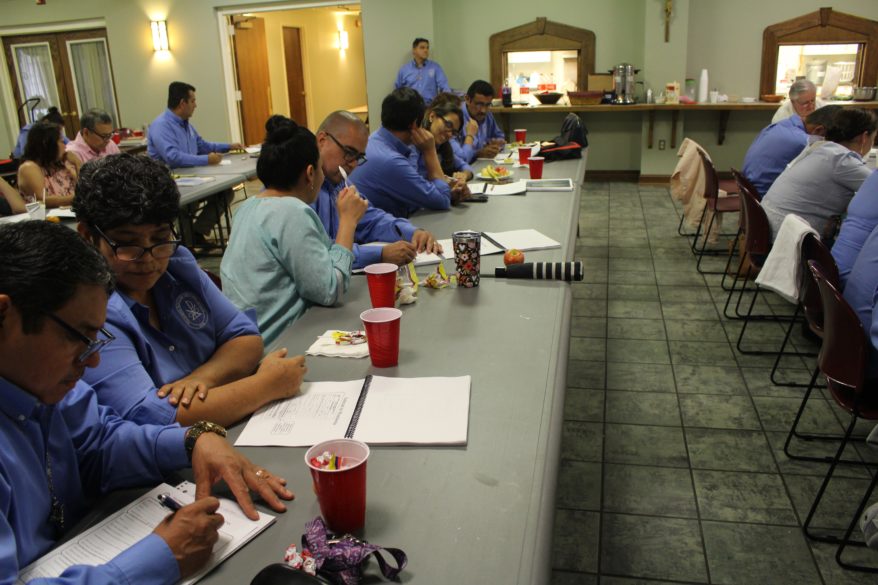
Tome nota
Vírgenes y Santos. Celebraciones
Dia del Trabajo. Labor Day. Lunes 2 de septiembre
Santa Teresa de Calcuta. Jueves 5 de septiembre
La Natividad de la Santísima Virgen María – Virgen de la Caridad del Cobre, Patrona Cuba. Domingo 8 de septiembre
San Pedro Claver lunes 9 de septiembre
Virgen de Coromoto, Patrona de Venezuela. Miércoles, 11 de septiembre
San Genaro jueves 19 de septiembre
San Pio de Pietrelcina. Lunes 23 de septiembre
San Gerónimo lunes 30
Convocatoria
Movimiento Familiar Cristiano invita a todas las parejas católicas, casadas o no, sean jóvenes, o mayores, con hijos o sin hijos. ¿Cuál es su enfoque? El MFFC está enfocado en el aprendizaje, crecimiento espiritual y la mejor convivencia entre los matrimonios y sus hijos, basados en valores cristianos.
No dude en contactar a Maribel y Juan Melo: (601) 209-3232 ó (601) 826-3005. Todavía está a tiempo de realizar su inscripción para el ciclo 2019 – 2020.
Curso Gratuito del Boston College. Todas las mujeres interesadas pueden inscribirse en el nuevo CURSO ONLINE GRATUITO de la Escuela de Teología y Ministerio del Boston College sobre “Las Mujeres en la Iglesia”, coordinado por la teóloga Maria del Pilar Silveira. INSCRIPCIONES AQUÍ: www.bc.edu/mujeres. Fecha del Curso: De septiembre 9, 2019 a octubre 14, 2019.
Último día para inscribirse: septiembre 4
Ambiente Seguro
Para reportar un abuso: Licenciada Valerie McClellan, trabajadora social.
Por favor, contáctela al 601-326-372
Dando gracias por aquellos que sirven
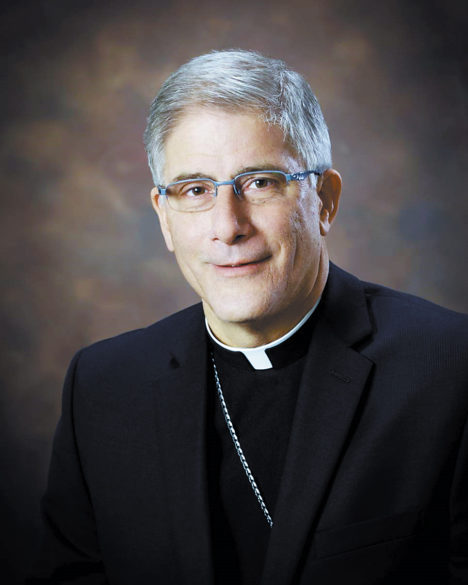
Por Obispo Joseph Kopacz
Una gran cantidad de personas en Misisipi continúan siendo afectadas por las recientes redadas, del Servicio de Inmigración y Control de Aduanas (ICE), a indocumentados en comunidades y lugares de trabajo en todo el centro de nuestro estado. Las familias directamente afectadas están luchando para abordar las necesidades inmediatas mientras se preguntan sobre lo que seguirá en las próximas semanas y meses.
Por otro lado, la respuesta de base a la crisis ha sido rápida y de gran alcance. Dos días después de su instalación, personas de 40 estados hicieron donaciones en la página web de Catholic Charities dedicada a los afectados por las redadas. Estas donaciones se contabilizaron rápidamente y se prepararon para su distribución de acuerdo con las solicitudes que inevitablemente vendrán de las familias en las cuales los proveedores están ausentes.
Esta respuesta masiva, en todo el estado y en todo el país, demuestra la generosidad del pueblo estadounidense, en nombre de los niños y las familias en crisis, debido a desastres naturales o provocados por el hombre. También indica que muchos estadounidenses están preocupados por nuestro quebrado sistema de inmigración y desean una solución justa y humana.
Todos los ciudadanos honorables saben que el respeto a la ley es una herramienta indispensable de una sociedad civilizada. Las leyes de nuestra nación son el fruto de casi 250 años de lucha por una sociedad más justa para todos.
En el caso de la inmigración en nuestras fronteras del sur, el estado de derecho está, regularmente, en desacuerdo consigo mismo y la resolución parece estar en un horizonte de constante retroceso. Esto es evidente por el conflicto entre las leyes de asilo, entrada legal a nuestro país y de ciudadanía por derecho de nacimiento. Esto no se resolverá fácilmente porque ha estado en un punto muerto, durante tres décadas y media, desde que Ronald Reagan concedió la amnistía en la década de 1980. Pero somos estadounidenses y el optimismo está alojado en nuestro ADN. Además, somos cristianos junto con personas de diversas tradiciones religiosas, y la esperanza es eterna.
Otro instrumento indispensable de una sociedad civilizada, que hace posible perseguir nuestros derechos inalienables, es la seguridad y la protección que las fuerzas del orden público brindan a nivel local, estatal y nacional. En nuestra nación, en la mayoría de los lugares, reina la ley y el orden debido a las fuerzas del orden y a una ciudadanía honorable. Con razón, el abuso de poder y la corrupción, dentro de la aplicación de la ley, siempre debe ser expuesto a la luz en todas las organizaciones, incluida la iglesia.
Por esto, el respeto es crucial, por aquellos que sirven en la aplicación de la ley, porque el caos sería inimaginable sin su presencia en nuestras comunidades y nación.
Entonces, gracias a los hombres y mujeres, que sirven a la ciudadanía a través de su vigilancia sobre nuestras largas costas y fronteras, por la preservación activa, en nombre de la ley y el orden, en innumerables comunidades en todo el país.
Otro instrumento vital de una sociedad civilizada es la salvaguarda de la libertad religiosa que nuestros fundadores apreciaron tanto, al punto que se consagró en la primera enmienda de la constitución. “El Congreso no hará ley alguna por la que adopte una religión como oficial del Estado o se prohíba practicarla libremente, …, o el derecho del pueblo para reunirse pacíficamente …” La sabiduría expresada en la Primera Enmienda prevé una asociación entre el gobierno y la religión en nombre del bien común o el bienestar general.
En este espíritu, en el Edificio Federal en Jackson el martes 13 de agosto, el Departamento de Seguridad Nacional, (Department of Homeland Security -DHS-, por su nombre y siglas en inglés), patrocinó un foro abierto del Subcomité para la Prevención de la Violencia Dirigida contra Comunidades Religiosas.
El siguiente es el memorándum que, Kevin K. McAleeman, Secretario Interino del Departamento de Seguridad Nacional, emitió el 20 de mayo; “En vista de los recientes ataques contra sinagogas, iglesias, templos y mezquitas, solicito que se restablezca rápidamente un Subcomité bajo el nombre de Concejo Asesor de Seguridad Nacional (HSAC) centrado en la seguridad de las organizaciones religiosas de todo el país.
Las casas de culto y las organizaciones sin fines de lucro basadas en la fe dedican recursos a las comunidades locales y, a menudo, sirven como faros sociales y morales en los que las personas confían en tiempos de problemas.
El derecho a practicar nuestras respectivas religiones, sin interferencia o miedo, es uno de los derechos más fundamentales e indelebles de nuestra nación. Por lo tanto, el ataque de extremistas violentos de cualquier ideología es particularmente aborrecible y debe evitarse. Si bien el Departamento de Justicia es responsable de investigar y procesar los ataques contra las instituciones religiosas, las misiones del DHS incluyen la preparación, prevención y mitigación de tales ataques. En apoyo de estas misiones, el DHS proporciona información, capacitación, ejercicios y experiencia sobre medidas de seguridad de protección a organizaciones religiosas “.
La preocupación por la violencia contra las comunidades religiosas no es una postura política en este momento en la historia de nuestra nación. El fin de semana pasado, el FBI y otros colegas encargados de hacer cumplir la ley evitaron un ataque contra un Centro Comunitario Judío en Youngstown, Ohio, a una hora al oeste de los asesinatos en la sinagoga en Pittsburg. Como es el caso en el 80% de tales amenazas y tiroteos masivos, el terrorista de cosecha propia, si sus planes no hubieran sido frustrados, habría sido un joven blanco supremacista. Parece que tenemos un cáncer creciente en el tejido social de nuestra nación y las comunidades basadas en la fe se encuentran en la mira de este odio imprudente.
Estuve agradecido de ser parte del panel de líderes religiosos, que estuvieron presentes en el foro, con funcionarios electos a nivel nacional y estatal, junto a representantes de fuerzas del orden de Natchez, Vicksburg y Jackson. Fue informativo e inspirador escuchar sobre las preocupaciones y esperanzas de los oradores y las preguntas de los panelistas que trataron de refinar la discusión en espera del eventual informe que será publicado por DHS el próximo mes. Sin lugar a duda, necesitamos construir puentes en nuestra sociedad para el bien de todos, donde gobierno y las comunidades religiosas sean socios efectivos para abordar los problemas apremiantes de nuestro tiempo.
Como se indicó anteriormente, “las casas de culto y las organizaciones sin fines de lucro, basadas en la fe, dedican recursos a las comunidades locales y, a menudo, sirven como los faros sociales y morales en los que las personas confían en tiempos de problemas”.
Como comunidades de fe católica, a través de la Diócesis de Jackson, en estrecha colaboración con nuestras Caridades Católicas, estamos orgullosos de ser un faro social y moral para muchos, en tiempos ordinarios y en tiempos de crisis tras las redadas.
El colapso en el tejido social de nuestra nación sería inimaginable sin la presencia, a través de toda nuestra nación, de comunidades e individuos basados en la fe. Construyamos y reconstruyamos juntos sobre la base de las fortalezas de nuestra nación.
Giving thanks for those who serve

By Bishop Joseph Kopacz
A large number of Mississippians continue to be affected by the recent raids and roundups of the undocumented in communities and workplaces across the center of our state by Immigration and Customs Enforcement (ICE). The families directly impacted are scrambling to address immediate needs while trying to make sense over what will follow in the weeks and months ahead.
On the other hand, the grassroots response to the crisis has been rapid and far-reaching. Within two days of being set up, donations were made by individuals from 40 states on the dedicated Catholic Charities web page for donations to those affected by the raids. These donations were expeditiously tallied and prepared for distribution to the requests that inevitably will come from the families whose breadwinner(s) are sidelined. This massive response, statewide and throughout the country demonstrates the generosity of the American people on behalf of children and families in crisis due to natural or man-made disasters. It is also an indication that many Americans are concerned about our broken immigration system and desire a just and humane solution.
All honorable citizens know that respect for law is an indispensable gage of a civilized society. The laws of our nation are the fruits of nearly 250 years of striving and struggling for a more just society for all. In the case of immigration at our southern borders, the rule of law regularly is at odds with itself and the resolution appears to be on an ever-receding horizon. This is evident in the conflict among the laws of asylum, of lawful entry into our country and of birthright citizenship. It will not be easily resolved, because it has been at an impasse for three- and one-half decades ever since Ronald Reagan granted amnesty in the 1980s. But we are Americans and optimism is embedded in our DNA. Moreover, we are Christians along with people of various faith traditions, and hope springs eternal.
Another indispensable gage of a civilized society that makes it possible to pursue our inalienable rights is the security and safety that law enforcement provides on the local, state and national levels. In our nation in most locales, law and order reigns because of law enforcement and an honorable citizenry. Rightly, abuse of power and corruption within law enforcement, must always be brought to the light of day in every organization, including the church. However, respect is crucial toward those who serve in law enforcement because the chaos would be unimaginable without their presence in our communities and nation. So, thank you to the men and women, who serve the citizenry through your vigilance over our expansive shores and borders, for your active preserve on behalf of law and order in countless communities throughout the land.
Another vital gage of a civilized society is the safeguarding of religious freedom that was so esteemed by our founding elders that it was enshrined in the first amendment of the constitution. “Congress shall make no law respecting an establishment of religion, or prohibiting the free exercise thereof…or the right of the people to peaceably assemble.” The wisdom embedded in the First Amendment envisions a partnership between government and religion on behalf of the common good or the general welfare.
In this spirit, at the Federal Building in Jackson on Tuesday, Aug. 13 Homeland Security sponsored an open forum sponsored by the Subcommittee for the Prevention of Targeted Violence Against Faith-Based Communities. The following is the memorandum that the Acting Secretary, Department of Homeland Security, Kevin K. McAleeman issued on May 20. “In light of the recent attacks against synagogues, churches, temples and mosques, I request you swiftly re-establish a Subcommittee under the Homeland Security Advisory Council (HSAC) focused on the security of faith-based organizations across the country. Houses of worship and faith-based non-profit organizations dedicate resources to local communities and often serve as the social and moral beacons people rely on in times of trouble. The right to practice our respective religions free of interference or fear is one of our nation’s most fundamental and indelible rights. Therefore, the targeting of violent extremists of any ideology is particularly abhorrent and must be prevented. While the Department of Justice is responsible for investigating and prosecuting attacks against faith-based institutions, DHS’s missions include preparedness, prevention, and mitigation of such attacks. In support of these missions, DHS provides information, training, exercises, and expertise on protective security measures to faith-based organizations.”
The concern over violence against faith-based communities is not political posturing at this time in our nation’s history. Just last weekend the FBI and other law enforcement colleagues averted an attack against a Jewish Community Center in Youngstown, Ohio, an hour west of the killings in the synagogue in Pittsburgh. As is the case in 80% of such threats and mass shootings, the home-grown terrorist, had his plans not been thwarted, would have been a young white male supremacist. We appear to have a growing cancer in the social fabric of our nation and faith-based communities find themselves in the crosshairs of this reckless hate.
I was grateful to be part of the panel of religious leaders who were on hand with elected officials at the national and state levels along with law enforcement from Natchez, Vicksburg and Jackson at the forum. It was informative and inspiring to hear about the concerns and hopes of the speakers and the questions of the panelists who sought to refine the discussion for the eventual report that will be published by Homeland Security next month. Without a doubt, we need to build bridges in our society for the good of all, and government and faith communities can be effective partners in addressing the pressing issues of our time.
As stated above, “houses of worship and faith-based non-profit organizations dedicate resources to local communities and often serve as the social and moral beacons people rely on in times of trouble.” As Catholic faith communities throughout the Diocese of Jackson, in close collaboration with our Catholic Charities, we are proud to be the social and moral beacons to many, in ordinary times, and in times of crisis in the aftermath of the raids and roundups. The breakdown in the social fabric of our nation would be unimaginable without the presence of faith-based communities and individuals across our nation. Let us build and rebuild together on the foundation of our nation’s strengths.

